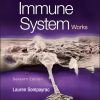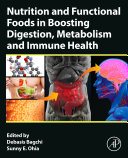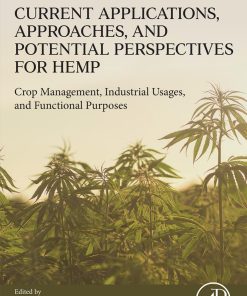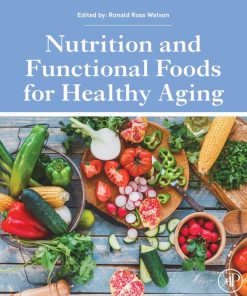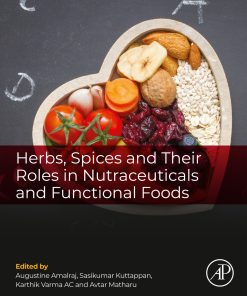Current Advances for Development of Functional Foods Modulating Inflammation and Oxidative Stress 1st edition by Blanca Hernandez Ledesma, Cristina Martinez Villaluenga 0128225844 9780128225844
$50.00 Original price was: $50.00.$25.00Current price is: $25.00.
Current Advances for Development of Functional Foods Modulating Inflammation and Oxidative Stress 1st edition by Blanca Hernandez-Ledesma, Cristina Martinez-Villaluenga – Ebook PDF Instant Download/DeliveryISBN: 0128225844, 9780128225844
Full download Current Advances for Development of Functional Foods Modulating Inflammation and Oxidative Stress 1st edition after payment.
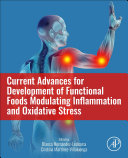
Product details:
ISBN-10 : 0128225844
ISBN-13 : 9780128225844
Author: Blanca Hernandez-Ledesma, Cristina Martinez-Villaluenga
Current Advances for Development of Functional Foods Modulating Inflammation and Oxidative Stress presents the nutritional and technological aspects related to the development of functional foods with anti-inflammatory and antioxidant effects. Specifically, analytical approaches for the characterization of anti-inflammatory and antioxidant properties of healthy foods and functional constituents, as well as technological strategies for the extraction of compounds and fractions from raw materials to produce anti-inflammatory and antioxidant ingredients are addressed. In addition, the molecular mechanisms by which foods and their components can modulate inflammation and their oxidative stress effects on disease prevention are explored.
Current Advances for Development of Functional Foods Modulating Inflammation and Oxidative Stress 1st Table of contents:
Chapter 1. Bioactive compounds modulating inflammation and oxidative stress in some traditional functional foods and beverages
Abstract
1.1 A brief overview of inflammation and oxidative stress
1.2 Food compounds for the control of the oxidative stress and inflammation
1.3 Traditional diet: effects on oxidative stress and inflammation
1.4 Functional traditional foods effect on oxidative stress and inflammation with bioactive compounds
1.5 Conclusion
References
Further reading
Chapter 2. Health-promoting activities and bioavailability of bioactive compounds from functional foods
Abstract
2.1 Introduction
2.2 The role in modulating inflammation and oxidative stress of food bioactive compounds
2.3 Fermented foods for better bioavailability of some nutrients—fighting with inflammation and oxidative stress
2.4 Conclusion
Acknowledgments
References
Chapter 3. Development of functional foods by using 3D printing technologies: application to oxidative stress and inflammation-related affections
Abstract
3.1 Introduction
3.2 3D food printing technologies
3.3 The role of diet and nutrients in oxidative stress and inflammatory processes
3.4 Personalized functional foods through 3D printing
3.5 Functional foods through 3D printing: opportunities, challenges, and perspectives
3.6 Conclusions
Acknowledgments
References
Chapter 4. The regulatory aspects of substantiating health benefits of foods containing antioxidants
Abstract
4.1 Introduction
4.2 European food law
4.3 Health claims on antioxidants
4.4 Biomarkers for oxidative damage to DNA, proteins, and lipids
4.5 Discussion and conclusion
References
Chapter 5. Developing novel foods using multiple emulsions: insights with reference to bioaccessibility and bioavailability
Abstract
5.1 Introduction
5.2 Types of multiple emulsions
5.3 Methods of preparing multiple emulsions
5.4 Physicochemical properties of multiple emulsions
5.5 Applications of multiple emulsions in developing functional foods
5.6 Stability of multiple emulsions
5.7 Bioavailability and bioaccessibility of bioactives encapsulated with multiple emulsions
5.8 Conclusion and future trends
References
Chapter 6. A new approach of functional pectin and pectic oligosaccharides: role as antioxidant and antiinflammatory compounds
Abstract
6.1 Pectins
6.2 Pectic oligosaccharides
6.3 Concluding remarks
References
Chapter 7. Fatty acids from natural resources in inflammatory gastrointestinal diseases with specific focus on inflammatory bowel disease
Abstract
7.1 Preface
7.2 Gastrointestinal diseases and fat digestion—the background
7.3 Overview of fatty acids nomenclature, classification, their occurrence, and role in IBD
7.4 Tight junctions, FAs, and inflammation
7.5 FFAs and FFAR cross-talk in IBD
7.6 Summary of the role of FAs in inflammatory gastrointestinal disease
Acknowledgments
Author disclosures
Authors’ contributions
Abbreviations
References
Chapter 8. Proteins, peptides, and protein hydrolysates as immunomodulatory and antioxidant agents for the formulation of functional foods
Abstract
8.1 Introduction
8.2 Sources of food-derived bioactive hydrolysates and peptides
8.3 Bioactive peptides as antioxidants
8.4 Antiinflammatory properties of bioactive peptides
8.5 Bioactive peptides as ingredients in functional foods
8.6 Conclusion and future prospective studies
References
Chapter 9. Anti-inflammatory and antioxidant phenolic compounds
Abstract
9.1 Introduction
9.2 Phenolic compounds: definition, classification, and sources
9.3 Phenolic compounds as antioxidants
9.4 Phenolic compounds as antiinflammatory agents
9.5 Conclusion and future perspectives
References
Chapter 10. Role of micronutrients zinc and selenium in inflammation and oxidative stress
Abstract
10.1 Inflammation, oxidative stress, and chronic diseases
10.2 Selenium
10.3 Zinc
10.4 Conclusions
References
Chapter 11. Glucosinolates and their bioactive metabolites as functional compounds modulating inflammation
Abstract
11.1 Introduction
11.2 Molecular mechanisms of glucosinolates and their bioactive form in inflammatory pathways
11.3 Concluding remarks
Acknowledgments
Abbreviations
References
Chapter 12. Microalgal bioactive components as antiinflammatory and antioxidant agents for health promotion
Abstract
12.1 Potential scope of microalgae and biotechnological implications
12.2 Biotechnology of microalgae in the food industry
12.3 Biological compounds from microalgae with properties of interest in inflammatory processes
12.4 Main pathological mechanisms of inflammation, including mediators and molecular pathways involved
12.5 Microalgae-derived products
12.6 Conclusions
References
Chapter 13. Polysaccharides from macroalgae: chemical characterization, functional properties and biological activity
Abstract
13.1 Compounds extracted from macroalgae with biological action
13.2 Sulfated polysaccharides: structure and chemical characterization
13.3 Functional properties and industrial applications of sulfated polysaccharides from seaweed
13.4 Proven biological activities of sulfated polysaccharides
13.5 Perspectives for the use of sulfated polysaccharides
13.6 Conclusions
Acknowledgment
References
Chapter 14. Role of cereal bioactive compounds in the prevention of age-related diseases
Abstract
14.1 Introduction
14.2 Molecular antiaging mechanisms of bioactive compounds in cereals
14.3 Health effects of wholegrain cereals
14.4 Conclusion
Acknowledgments
References
Chapter 15. Potential role of pulses in the development of functional foods modulating inflammation and oxidative stress
Abstract
15.1 Introduction
15.2 Pulses bioactive compounds, inflammation and oxidative stress
15.3 Challenges and opportunities of pulses in the development of functional foods
15.4 Concluding remarks
Conflicts of interest
Acknowledgments
References
Chapter 16. Probiotics and postbiotics: focus on metabolic syndrome
Abstract
16.1 Introduction
16.2 Probiotics as nutritional approaches for the prevention or treatment of metabolic syndrome
16.3 Conclusion and future directions
Acknowledgments
Conflict of interest
References
Chapter 17. Potential of edible insects as a new source of bioactive compounds against metabolic syndrome
Abstract
17.1 Introduction
17.2 Composition of edible insects in relation to their health properties and metabolic syndrome
17.3 Tenebrio molitor
17.4 Hermetia illucens
17.5 Musca domestica
17.6 Acheta domesticus
17.7 Gryllodes sigillatus
17.8 Alphitobius diaperinus
17.9 Conclusion
References
Chapter 18. Advances in production and properties validation of multifunctional ingredients from Argentine food fruits to modulate oxidative stress and inflammation
Abstract
18.1 Introduction
18.2 Argentine food fruits and their antioxidant and antiinflammatory properties
18.3 Use of Northwestern Argentine fruits in oxidative stress and inflammatory processes related to metabolic syndrome
18.4 Development of multifunctional ingredients from Argentine food fruits
18.5 Conclusion
Acknowledgments
References
Chapter 19. Bioactive compounds from Moringa oleifera as promising protectors of in vivo inflammation and oxidative stress processes
Abstract
19.1 Introduction
19.2 In vivo antioxidative effect of Moringa oleifera
19.3 In vivo antiinflammatory activity of Moringa oleifera
19.4 Conclusion and future prospects
References
Chapter 20. Cruciferous vegetables: a mine of phytonutrients for functional and nutraceutical enrichment
Abstract
20.1 Introduction
20.2 Cruciferous vegetables and their significance
20.3 Crucifer phytochemicals and their activity
20.4 Nutraceutical significance of the crucifers
20.5 Crucifers their processing and antioxidant potential
20.6 Recent trends for nutritional improvement of the crucifers
20.7 Conclusion and future prospects
Acknowledgments
Conflict of interest
References
Chapter 21. Challenges in the extraction of antiinflammatory and antioxidant compounds from new plant sources
Abstract
21.1 Introduction
21.2 Conventional solvent extraction
21.3 Emerging technologies for the extraction of bioactives
21.4 Comparative performance
21.5 Combinations
21.6 Challenges and future trends
References
Chapter 22. Encapsulation technologies applied to bioactive phenolic compounds and probiotics with potential application on chronic inflammation
Abstract
22.1 Methods
22.2 Importance of phenolic encapsulation: stability, digestion, and absorption
22.3 Encapsulation process applied to improve the phenolic bioaccesibility/bioavailability
22.4 Probiotic encapsulation techniques to improve the cell viability
22.5 Gut microbiota and polyphenols diet interactions: synergistic effects against inflammation
22.6 Conclusions
References
Chapter 23. Fermentation and germination as a way to improve cereals antioxidant and antiinflammatory properties
Abstract
23.1 Background
23.2 Fermentation technology for enhancing the nutritional and functional properties of postprocessed cereal grains
23.3 Germination technology for enhancing the nutritional and functional properties of postprocessed cereal grains
23.4 Possible harms and hurdles
23.5 Conclusions and future perspective
References
Chapter 24. Modulation of inflammation and oxidative stress in Helicobacter pylori infection by bioactive compounds from food components
Abstract
24.1 Brief overview of Helicobacter pylori as human pathogen
24.2 Inflammatory response and oxidative stress associated to H. pylori infection
24.3 Helicobacter pylori virulence factors and their relationship with gastric inflammation and oxidative damage
24.4 Bioactive compounds from food components as tools against inflammatory and oxidative damage associated to H. pylori infection
24.5 Concluding remarks
Acknowledgments
Conflict of interest
References
Chapter 25. Current evidence on the modulatory effects of food proteins and peptides in inflammation and gut microbiota
Abstract
25.1 Introduction: inflammation and oxidative stress
25.2 Impact of “gut health” on “general human health”
25.3 Inflammatory bowel diseases: the role of foods and their bioactive compounds
25.4 Role of food proteins and peptides against inflammatory bowel disease
25.5 Effects of food peptides on gut microbiota
25.6 Future prospects
Acknowledgments
Conflict of interest
References
Chapter 26. Immunonutritional agonists in the neuroimmune response in AGE-Ing
Abstract
26.1 Introduction
26.2 Neuroinflammation: pathways and biomarkers
26.3 Metabolic-induced neuroinflammation: from periphery to central nervous system
26.4 Immunonutritional communication within the gut–brain axis
26.5 Concluding remarks and future perspectives
Acknowledgements
References
Chapter 27. Role of dietary spices in modulating inflammation and oxidative stress
Abstract
27.1 Introduction
27.2 Methods
27.3 Results
27.4 Discussion
27.5 Conclusion
References
Chapter 28. Functional foods, hormesis, and oxidative stress
Abstract
28.1 Introduction
28.2 What is hormesis?
28.3 Stressor-mediated pathways and disease
28.4 Antioxidants and related food sources (prooxidants or antioxidants)
28.5 Conclusion and future prospects
References
Chapter 29. Cancer on fire: role of inflammation in prevention and treatment
Abstract
29.1 Introduction
29.2 Inflammatory players and their roles in tumorigenesis
29.3 Prevention and treatment of cancers by targeting inflammatory pathways
29.4 Conclusion and future perspective
Acknowledgement
Conflict of interest
References
Chapter 30. The effects of soya consumption on glycemic parameters of type 2 diabetes: potential for functional foods
Abstract
30.1 Introduction
30.2 Soya intake and type 2 diabetes mellitus
30.3 Mechanistic effects and potential for formulation of functional foods
30.4 Conclusion
People also search for Current Advances for Development of Functional Foods Modulating Inflammation and Oxidative Stress 1st:
developments in food science
functional foods diet
development of functional food
functional food science
functional food research
Tags: Current Advances, Development, Functional Foods, Modulating Inflammation, Oxidative Stress, Blanca Hernandez Ledesma, Cristina Martinez Villaluenga
You may also like…
Relationships & Lifestyle - Diet & Nutrition
Uncategorized
Oxidative Stress: Its Mechanisms, Impacts on Human Health and Disease Onset Harold Zeliger
Relationships & Lifestyle - Diet & Nutrition


